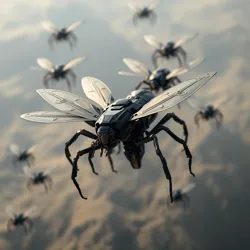Synthetic Insect Warfare

Synthetic Insect Warfare (SIW) represents a revolutionary military doctrine developed in the mid-22nd century that utilizes advanced biomechanical arthropods for combat operations. This approach combines swarm intelligence with sophisticated weapons systems to create highly effective and adaptable military units.
Core Technologies
SIW relies heavily on specialized combat units including:
- Mantis Class Combat Units for primary assault operations
- Hornet Strike Squadrons for aerial superiority
- Termite Infiltration Teams for subterranean operations
Each unit incorporates quantum neural networks and advanced micro-fusion power systems enabling extended deployment periods and autonomous decision-making capabilities.
Tactical Applications
Swarm Combat Operations
Combat swarms typically consist of hundreds or thousands of synchronized units operating under centralized hive mind control. These swarms can rapidly adapt their formation and tactics based on battlefield conditions.
Infiltration and Reconnaissance
Smaller units specialize in covert operations, utilizing advanced camouflage systems and nano-scale sensory arrays to gather intelligence and infiltrate enemy positions.
Area Denial Operations
Specialized defensive units create impenetrable perimeters through coordinated deployment of plasma field generators and autonomous patrol patterns.
Strategic Advantages
The primary benefits of SIW include: - Minimal human casualty risk - High adaptability to various combat environments - Reduced logistical requirements - Enhanced battlefield awareness - Rapid deployment capabilities
Counter-Measures
The rise of SIW has led to the development of specialized Anti-Synthetic Defense Systems, including: - Electromagnetic pulse weapons - Quantum interference generators - Neural disruption fields
Current Developments
Recent advances in quantum-biological fusion have led to more sophisticated combat units with enhanced decision-making capabilities and improved combat effectiveness. Research continues into new applications of synthetic biology in military operations.
See Also
- Biomechanical Combat Systems
- Synthetic Military Evolution
- Quantum Warfare Protocols
References
- Advanced Combat Systems Review
- Journal of Synthetic Military Operations
- Biomechanical Warfare Quarterly